Are you seeking clarity on the types of traumatic spinal cord injuries and how they can impact your life?
Understanding the different types of traumatic spinal cord injuries, including their causes, symptoms, and treatment options, is essential for informed decision-making and management of this condition.
By learning about the various types of traumatic spinal cord injuries and their implications, individuals and their families can gain valuable insights into their specific situation and access the resources and support needed to navigate this challenging journey toward recovery and well-being.
Check this comprehensive guide on traumatic spinal cord injuries. Understand the information provided to equip yourself for your journey towards recovery.
What are the different types of traumatic spinal cord injury?
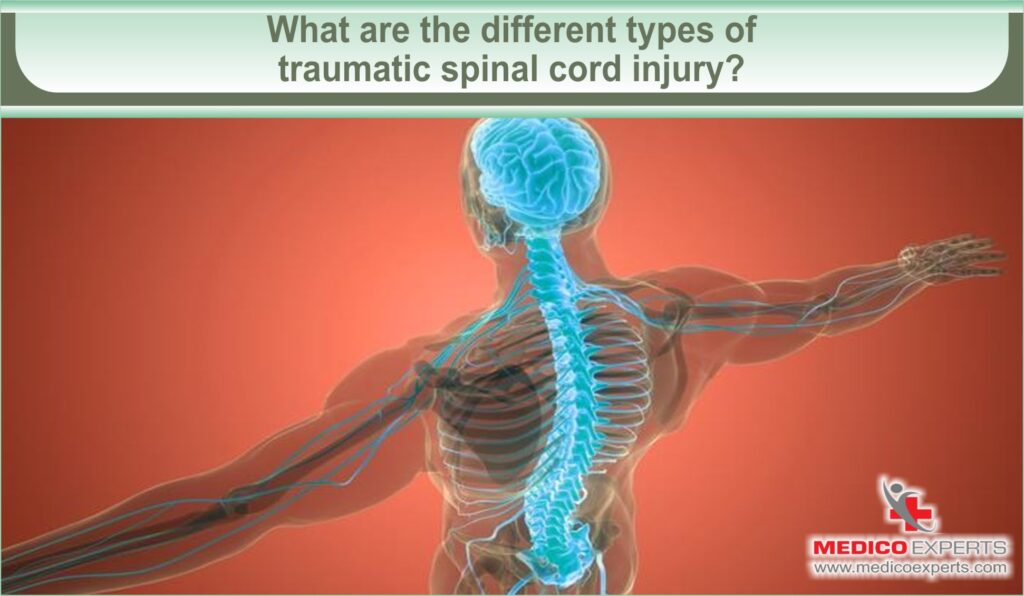
The purpose of the spinal cord is to transmit information between the brain and the body. If someone has a spinal cord injury, they may lose certain bodily functions because the nerves are unable to communicate with the brain. It’s important to know about the different types of spinal cord injuries and their associated symptoms.
There are two distinct kinds of injuries that may occur to the spinal cord:
1. Complete:
A complete injury results in the complete loss of function below the site of the injury, affecting both sides of the body. This can lead to quadriplegia (paralysis of all four limbs) or paraplegia (paralysis of the lower half of the body).
For example, if the injury occurs in the cervical area of the spine (neck), it would cause paralysis of all four limbs. This results in the loss of sensation and movement in all limbs, as well as the chest and abdomen.
2. Incomplete:
When someone experiences an incomplete injury, they might still have some degree of function on one or both sides of their body. The body and brain are still able to communicate through certain pathways.
For example, if the injury is in the thoracic area of the spine (upper back) someone might have movement or feeling in their arms and hands but still be paralyzed from the waist down.
Now that you are aware of the types, let us move on to understand what are the most common levels of traumatic spinal cord injuries and their effects.
Read on!
What are the various levels of spinal cord injury and how do they impact the body?
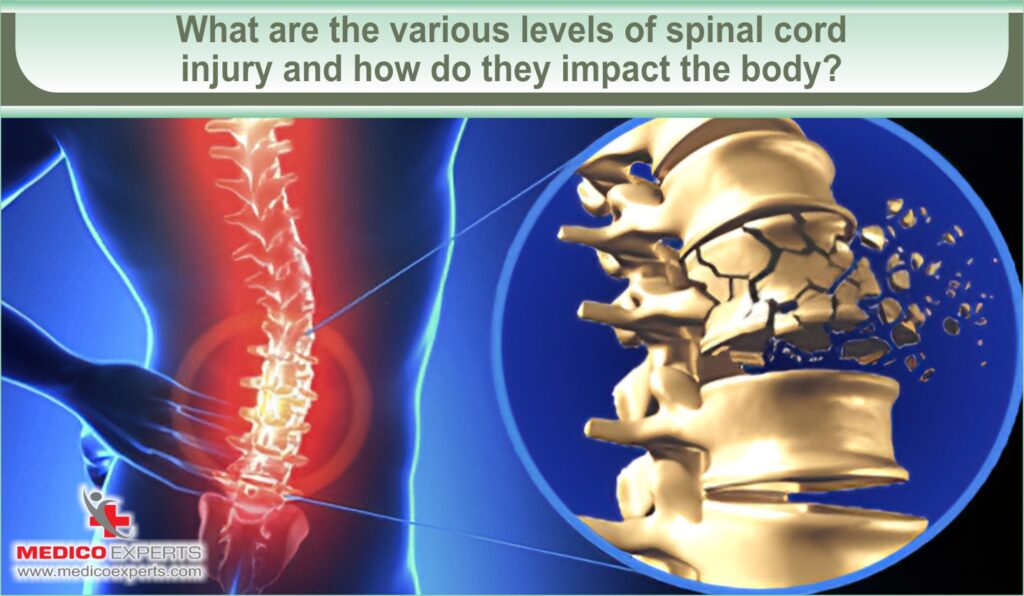
There are four levels of spinal cord injury: cervical, thoracic, lumbar, and sacral. Each level affects different parts of the body.
Cervical Spinal Cord Injuries:
This is the highest level of spinal cord injury and affects the head, neck, arms, hands, torso, and legs.
Injuries to this area can result in quadriplegia or paraplegia. The difference between paraplegia and quadriplegia is that paraplegia affects the lower half of the body, whereas quadriplegia affects all four limbs.
Some of the common symptoms associated with cervical spinal cord injuries are loss of sensation and movement in arms, hands, and legs, loss of bladder and bowel control, difficulty breathing, and pain in the arms, neck, or shoulders.
Thoracic Spinal Cord Injuries:
The thoracic spine is situated in the upper and middle regions of the back.
Injuries to the mid-back can cause paralysis of the legs and trunk, as well as loss of function in the arms and hands.
Some of the common symptoms associated with Thoracic spinal cord injuries as lower back pain along with a fever, and experience a loss of sensation in your genitals or rectal area, and a lack of the ability to control your urine or stool, it could be due to a fall or injury.
Lumbar Spinal Cord Injuries:
L1 through L5 are the five vertebrae that make up the lumbar spine, which may be found just below the thoracic region of the spine and directly above the minor sacral spine section. It is the lowest main portion of the spinal cord.
The lumbar section of the spine has larger vertebrae compared to the thoracic and cervical sections because it carries the most weight.
Some common symptoms associated with lumbar spinal cord injuries are pain in the lower back and buttocks, loss of sensation in the legs, and difficulty walking or controlling one’s balance.
Sacral Spinal Cord Injuries:
The sacral spine is situated in the uppermost part of the buttocks.
Injuries to this area can cause paralysis of the lower body, as well as loss of function in the feet and legs. Although the sacrum does not have a spinal cord, its nerves originate from the lumbar spine. If the nerve roots in the sacrum and lower lumbar spine are injured, it may lead to signs similar to spinal cord injury.
Some common symptoms associated with sacral spinal cord injuries are the inability to control bowel or bladder movements, pain in the lower back, pain in my legs that may radiate to the back of the leg(s), and sensory issues in my groin and buttocks region.
Now that we have seen the types and levels of traumatic spinal cord injuries, let us understand the extent and severity of this.
How to determine the extent and severity of a patient’s spinal cord injury?
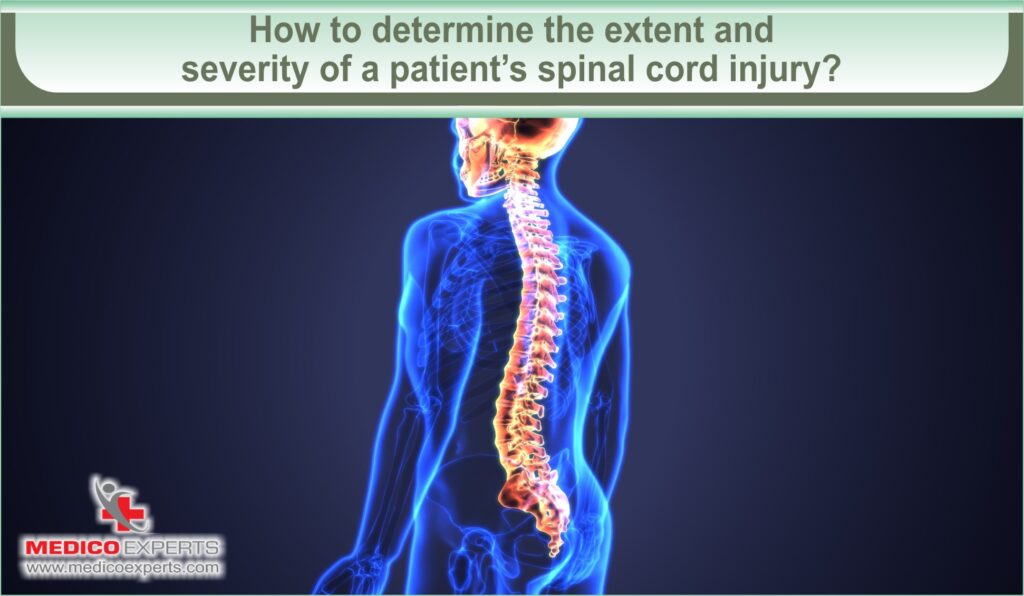
The extent and severity of a patient’s spinal cord injury can be determined by assessing the level of damage to the nerve fibers in the spinal cord.
Damage to the nerve fibers will result in the loss of sensation, motor control, and reflexes below the site of injury. The more extensive the damage, the more severe and widespread these symptoms may become.
Doctors will also take into consideration the patient’s overall health and any underlying medical conditions. This is to ensure that they can cope with the effects of the injury.
In the grading system, Grade A is considered the most serious, and Grade E is considered the least serious.
- Grade A refers to a condition where there is a total absence of sensory and motor functions below the site of the injury.
- According to medical terminology, having a Grade B injury entails a loss of motor function below the affected area, without affecting sensory function.
- The patient has a Grade C spinal cord injury, indicating they have retained some sensory and motor function below the site of the injury. However, over half of the major muscles in their body are graded below 3. While they can move their limbs horizontally, they experience difficulty moving them against gravity.
- The patient has a Grade D injury, which indicates that there is preservation of sensory and motor functions below the level of the injury. Additionally, the patient’s muscle grade for more than half of their major key muscles is above 3. They can move their limbs through their full ranges of motion against gravity and with moderate resistance.
- A Grade E indicates that both the sensory and motor functions are normal.
Learn more about the traumatic spinal cord injury types diagnosis here.
Are there any treatments available for both complete and incomplete spinal cord injuries?
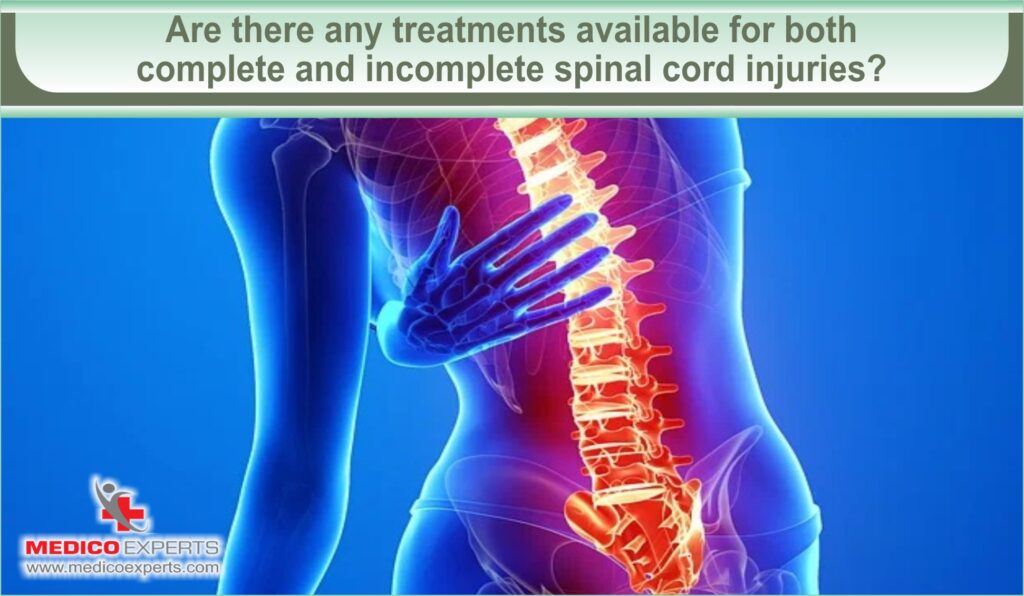
Depending on the extent and severity of the injury, there are several treatments available for traumatic spinal cord injuries.
1. Physical therapy
It helps to maintain existing muscle function, as well as address any secondary issues such as bedsores or pain management.
2. Occupational therapy
It helps the patient learn how to adapt and complete activities of daily living while using adaptive devices. Assistive devices such as wheelchairs or walkers can also help improve mobility.
3. Stem Cell therapy
A promising advanced option for spinal cord injury is being studied in clinical trials. This therapy uses stem cells to help the body regenerate damaged nerve fibers, and potentially restore some of the lost function.
Visit the page to learn more about stem cell treatment for spinal cord injury
4. Decompression therapy
It is another treatment option that can be used to help reduce pressure on the spinal cord. This procedure involves surgically removing any bone fragments or discs that are impinging on the nerves in the spinal cord, which can help improve symptoms.
5. Emotional and Psychological therapies
These therapies are available for patients with traumatic spinal cord injuries. These therapies can help the patient adjust to their new lifestyle as well as cope with any associated pain or depression.
6. Medications
Medication may be prescribed to address any secondary issues such as pain, spasticity, or bladder control.
7. Surgery
Surgery is another option for treating traumatic spinal cord injuries, though this is typically reserved for more serious cases. Surgery can be used to relieve pressure on the spinal cord, repair fractures, or remove any foreign objects that are causing damage.
There is no one-size-fits-all solution when it comes to treating traumatic spinal cord injury types, so each patient must work with their doctor to develop a comprehensive treatment plan.
How Effective is Stem Cell Treatment for Complete and Incomplete Spinal Cord Injury?
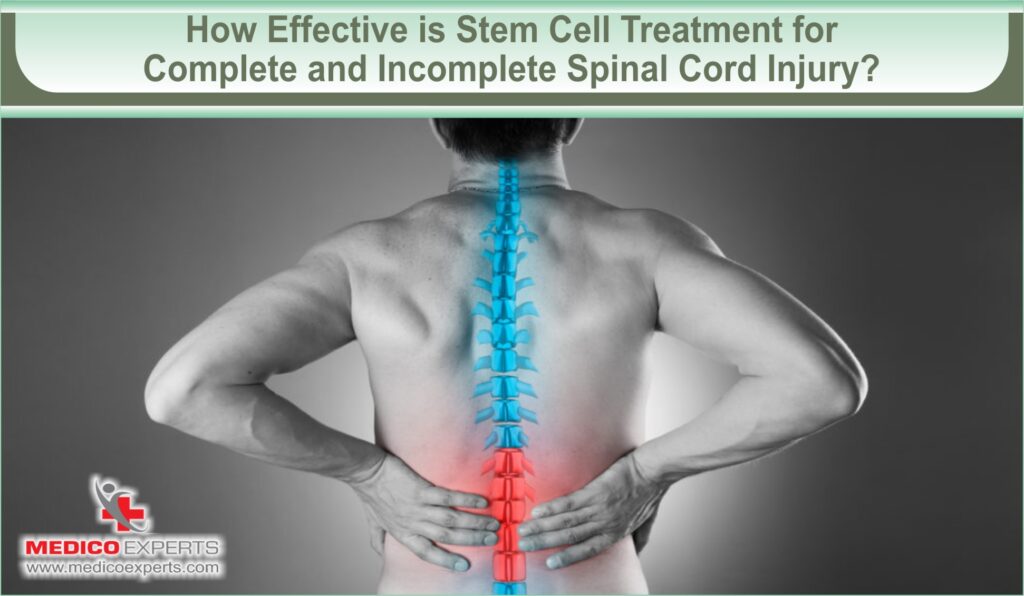
When a person suffers from spinal cord injury (SCI), they may lose the ability to control their muscles and feel sensations due to damage in their nervous tissue. However, it may be possible to repair the spinal cord by introducing stem cells, which have the unique ability to replenish themselves and transform into any cell in the body.
Experimental models have shown positive outcomes for treating spinal cord injuries (SCI) using stem cells. These stem cells can be trained to become neural cells like neurons and glia, which can replace the lost neural cells due to SCI. Transplanted stem cells have also demonstrated neuroprotective properties and promoted axon regeneration.
As research progresses, treating traumatic spinal cord injuries with this method is becoming safer and more effective.
Learn more on the stem cell procedure for spinal cord injury in India here…
Conclusion
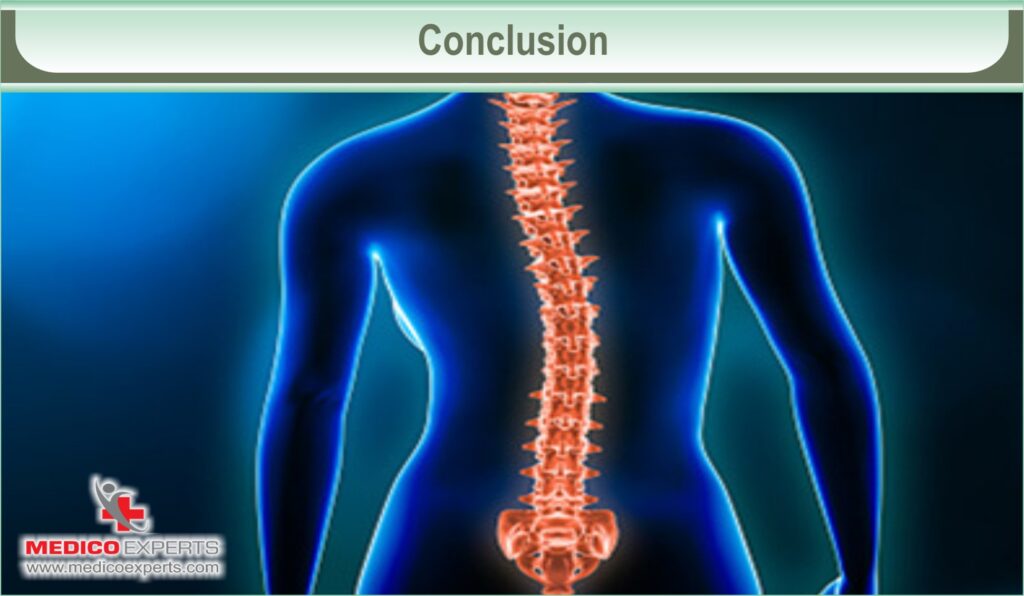
Understanding the types of traumatic spinal cord injury will help you make your recovery journey successful. By familiarizing yourself with each type’s causes, symptoms, and treatment options, you can make informed decisions about your care and rehabilitation plan.
It is important to remember that each case is unique and requires personalized care. Hence it is important to work with healthcare professionals. We at MedicoExperts keep ourselves updated with the latest advancements in this field and provide comprehensive care for traumatic spinal cord injury types.
MedicoExperts has a network of highly experienced super-specialized doctors and well-equipped hospitals located worldwide. We provide second opinions and guidance to people with trauma-related spinal cord injuries, enabling them to access the latest diagnostic techniques and treatments.
Book an appointment with us today to get a specialized treatment plan as per your requirements.
FAQ :
Q1. What is the most common spinal trauma?
A: The most common type of spinal trauma is a traumatic cervical spine injury, which occurs in the upper part of the neck and can lead to various forms of paralysis.
Q2. What is the difference between a spinal injury and a spinal trauma?
A: Spinal injury refers to any damage or trauma that is sustained in the spine, while spinal trauma specifically refers to a traumatic event such as an accident, fall, or blow that causes injury to the spine.
Q3: What is the most serious type of spinal cord injury?
A: The most serious type of spinal cord injury is a complete injury, in which the patient loses all feeling and movement below the level of injury.
Q4. Can stem cells repair a damaged spinal cord?
A: Stem cell therapy is a promising advanced option for spinal cord injury that is being studied in clinical trials. This therapy uses stem cells to help the body regenerate damaged nerve fibers, and potentially restore some of the lost function. The team at MedicoExperts is well-versed in this field and can guide those considering stem cell treatment.
Q5: What are the emotional effects of a spinal injury?
A: Spinal injuries can have serious emotional and psychological effects on patients, such as depression, anxiety, and personality changes. It is important to seek out psychological therapies and support from family and friends to cope with any emotional issues associated with a spinal injury.
References
https://www.ncbi.nlm.nih.gov/books/NBK560721/
https://www.ninds.nih.gov/health-information/disorders/spinal-cord-injury
https://www.ncbi.nlm.nih.gov/books/NBK448146/
https://www.mayoclinic.org/diseases-conditions/spinal-cord-injury/symptoms-causes/syc-20377890
https://www.ncbi.nlm.nih.gov/pmc/articles/PMC4118226/



